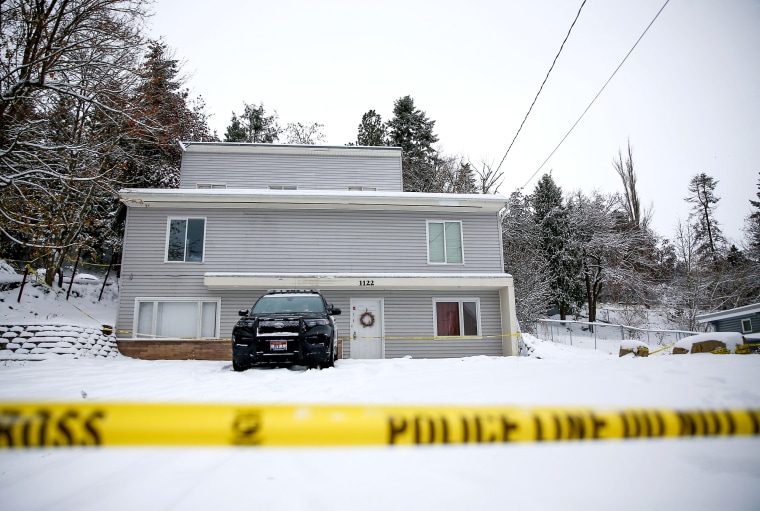New details in the investigation into the killings of four University of Idaho students in November were revealed in court documents unsealed on Thursday, Jan. 5.
Bryan Christopher Kohberger, 28, was arrested on Dec. 30 and charged with four counts of murder and one felony burglary charge in connection with the deaths of Ethan Chapin, 20, Xana Kernodle, 20, Madison Mogen, 21, and Kaylee Goncalves, 21.
In an affidavit, authorities laid out evidence linking Kohberger to the crime, including DNA samples, cell phone records and the movements of a white Hyundai Elantra. The affidavit also revealed new details from interviews with the roommates who were home during the attack and survived. Here's what we learned:

DNA evidence
According to the affidavit, a tan leather knife sheath with "Ka-Bar" and "USMC," along with U.S. Marine Corps insignia stamped on it, was located on a bed in the home next to Mogen's body while processing the crime scene on Nov. 13.
Investigators were able to locate a "single source of male DNA" left on the button snap of the knife sheath, according to the affidavit.
Police recovered trash on Dec. 27 from Kohberger's parents' home in northeastern Pennsylvania, and the DNA from the knife sheath showed a connection to the DNA profile obtained from the trash, the affidavit states.
Police said during a press conference on Dec. 30 that the weapon used in the attack, believed to be a fixed-blade knife, has still not been located.
Surviving roommate says she saw the attacker
Police have said two roommates were home at the time of the attack and were not injured. Both roommates spoke with investigators, according to the affidavit, and one said she came almost face-to-face with the suspect.
Both roommates — Dylan Mortensen and Bethany Funke — have previously come forward in a letter stating they are struggling to accept why the lives of “four beautiful people” were taken so brutally.
Mortensen, identified as D.M. in the affidavit, said she was first awoken around 4 a.m. on Nov. 13 when she heard what she thought was Goncalves playing with her dog in a bedroom upstairs.
"A short time later, D.M. said she heard who she thought was Goncalves say something to the effect of "there's someone here,'" the affidavit states.
The affidavit notes the voice could have been Kernodle, as she received a DoorDash order around 4 a.m., and cell phone records indicated she was likely awake and on TikTok around 4:16 a.m.
Mortensen said she looked around after hearing the comment about someone being inside of the house, but did not see anyone in the residence.

The roommate told investigators she opened her bedroom door for a second time when she heard what she thought was crying coming from Kernodle's room.
"D.M. then said she heard a male voice say something to the effect of, 'It's ok, I'm going to help you,'" according to the affidavit.
Mortensen said she opened her door for the third time after hearing the crying, coming into contact with a figure wearing black clothing and a mask who was walking toward her. She described the person as male, 5 feet 10 inches or taller and "not very muscular, but athletically built with bushy eyebrows."
She told investigators she was in a "frozen shock phase" and the man walked past her, toward a sliding glass door. She said she locked herself in her room after seeing the man, whom she didn't recognize, according to court documents.
It is unclear why neither roommate called 911 until around noon. Police have said they do not believe the two surviving roommates were involved in the attack.
Cell phone records

Law enforcement obtained search warrants for cell phones used near the victims' residence around the time of the slayings, and Kohberger's phone initially did not show up.
Investigators suspected he may have turned off his phone before he arrived on the scene, and applied for another search warrant for Kohberger's phone records between Nov. 12 and Nov. 14.
The records showed the phone traveling through Pullman, Washington, around 2:47 a.m. on Nov. 13, when the phone stopped reporting to the cellular network. Investigators believe Kohberger either disabled the phone or turned it off, according to the affidavit.
The phone doesn't report to the network again until 4:48 a.m., according to the affidavit, which showed the phone heading from Idaho toward Washington.
Phone records also indicate Kohberger left his residence around 9 a.m. and traveled to the area near the victims' residence for about 10 minutes, before returning home around 9:32 a.m.
Investigators obtained another search warrant to determine if Kohberger had "stalked any of the victims in this case prior to the offense." The records indicated Kohberger's phone had been near the victims' residence at least 12 times between June 23, 2022 and Nov. 13, 2022, according to the affidavit.
"All of these occasions, except for one, occurred in the late evening and early morning hours of their respective days," the affidavit states.
Tracking the Hyundai Elantra
As part of the investigation, law enforcement sought out any footage from the area the morning of the killings.
According to the court documents, police found footage of what they believe to be the white Hyundai Elantra involved in the slayings the morning of the incident at 3:25 a.m. The vehicle passed by the King's Road residence three times, starting at 3:29 a.m.
The fourth time the car passed by the home was at 4:04 a.m., the affidavit says, and it was then seen leaving the neighborhood at a high rate of speed at 4:20 a.m. Police believe that Kohberger left town by heading south out of Moscow, Idaho, and then took a longer, more circuitous route back to his residence Pullman, Washington.
WSU cameras picked up the sedan departing Pullman the morning of the killings around 2:44 a.m. and heading east toward Moscow and returning about 5:25 a.m.
After Moscow Police Department asked law enforcement to be on the lookout for the white Hyundai Elantra on Nov. 25, a WSU officer searched the school database and found Kohberger's registration to a student apartment complex in Pullman on Nov. 29 at 12:28 a.m. Less than 30 minutes later, another WSU officer found Kohberger's car in the parking lot of the building while searching for white Hyundai Elantras.
Kohberger had been stopped by police twice before the Nov. 13 killings, according to the affidavit. He was pulled over for traffic stops on Aug. 21 in Moscow, Idaho, and again on Oct. 14 at WSU, both times in the white sedan with license plate LFZ-8649 from Pennsylvania.
On Nov. 18, Kohberger registered the white Hyundai Elantra to get Washington state plates, the affidavit said.
His car was then spotted by a plate reader in Loma, Colorado, on Dec. 13, police said in the court documents. Then, Kohberger was stopped twice by officers in Hancock County, Indiana, for following too closely. Finally, on Dec. 16, the car police believe to be Kohberger's was spotted in Albrightsville, Pennsylvania, where his parents live and he was arrested there, 14 days later, on Dec. 30.

